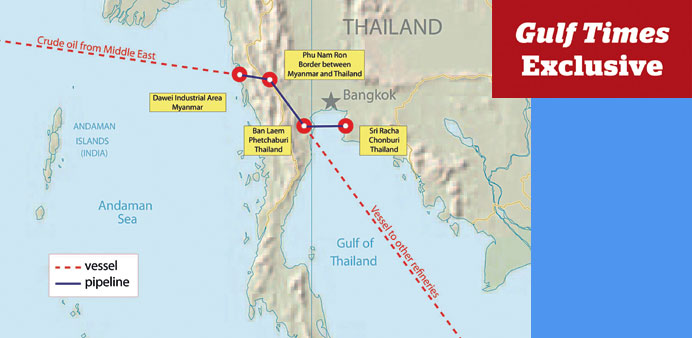The land bridge concept for the transport of crude oil from the Mieast through Dawei and across Thailand to East Asian refineries. Source: Dawei Development Company
By Arno Maierbrugger/Gulf Times Correspondent/Bangkok
An agreement signed earlier in July between Japan, Myanmar and Thailand on the mutual development of the long-delayed Dawei Special Economic Zone in Myanmar will lead to the opening a new trade axis between the Middle East and East Asia. When completed, planners expect the zone to be the largest of its kind in entire Southeast Asia and a new economic gateway linking the Indian and the Pacific Oceans.
Dawei, a village located at the Andaman coast in southeastern Myanmar very close to the Thai border, is supposed to be transformed into a special economic zone including a deep-sea port under a project that actually dates back a couple of years and was suspended in 2013 as the then-Shinawatra government in Thailand missed to arrange necessary credit lines from Japan to go ahead with the project.
However, relations have improved, and on July 4, the said agreement has been signed in Tokyo on the sidelines of the 7th Mekong-Japan Summit. In a next step, on July 24, Italian-Thai Development Plc, one of the largest construction firms in Thailand, through its subsidiary Dawei Development Company will sign a contract with the Myanmar government to develop and kick off works at the zone. Dawei Development Company will also be commissioned by the Myanmar government to operate the Dawei Special Economic Zone for at least 50 years.
Development of phase one will cover 27 square kilometres, and the initial investment is estimated to reach $1.7bn. The first piece of infrastructure to be built is a 138-kilometer road stretch from Dawei to Kanchanaburi province, 119 kilometres northwest of Bangkok, where it will come up on other transnational highways. Further developments will include the construction of public utilities, liquefied natural gas yards, a power plant and the port.
The final size of the Dawei Special Economic Zone is expected to be 205 square kilometres, whereby the project is backed by development loans worth $6.1bn assigned by Tokyo. The entire costs of the project are believed to be more than $8bn.
When finished, the new economic zone will allow cargo to bypass the narrow and congested Strait of Malacca to forge shorter trade routes from the Middle East and Africa to China, Japan and other parts of Southeast and East Asia. It will probably also put an end to the controversy around the much-discussed Kra Canal, a project that entails digging a canal across the smallest part of the Thai Isthmus to cut a new shipping line between the Indian Ocean and the South China Sea. Another reason for Japan’s interest in the revived project is to counter Thailand’s influence in Myanmar, which welcomes the much-needed infrastructure for its rapidly emerging economy. Dawei’s road connections to Thailand, Cambodia and Vietnam and the planned deep-sea port will give regional traders easy access to global markets and, in turn, will make it an attractive location for Middle East oil and gas shipments keen to reach the Southeast and East Asian markets, as well as for Western companies to reach out to other economic development areas such as the Mekong region and to plug into Myanmar’s plentiful natural resources and low labour costs and avoid shipping via the Strait of Malacca, especially after the launch of the Asean Economic Community at the end of 2015 which will reduce tariffs on trade across the region.



